
English Instructional Plan – American or British Romantic Poetry Analysis
- Subject:
- English
- Reading
- Material Type:
- Lesson Plan
- Author:
- VDOE Project Team
- Date Added:
- 04/19/2022

English Instructional Plan – American or British Romantic Poetry Analysis
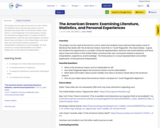
This project can be used at the end of a unit in which the students have read and discussed a work of literature that deals with The American Dream; here that is F. Scott Fitzgerald's The Great Gatsby. It gives the students the opportunity to consider a fictional representation, examine real world statistics and facts about class and status in the United States, and draw their own conclusions based on personal interpretation, experience, and knowledge. The final product is a visual representation and written explanation of that personal interpretation.
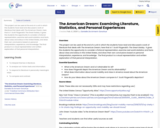
This project can be used at the end of a unit in which the students have read and discussed a work of literature that deals with The American Dream; here that is F. Scott Fitzgerald's The Great Gatsby. It gives the students the opportunity to consider a fictional representation, examine real world statistics and facts about class and status in the United States, and draw their own conclusions based on personal interpretation, experience, and knowledge. The final product is a visual representation and written explanation of that personal interpretation.

Students will analyze multiple sources to determine which of the causes of the Civil War each source best supports. Students will support their choices with evidence from the source and their own understanding of the causes of the Civil War.
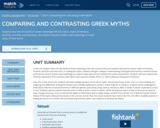
In this unit students dive into the world of Greek mythology. Over the course of the unit students will read the classic myths of Pandora, Arachne, and Echo and Narcissus. In reading the myths, students will gain a deeper understanding of the gods and mortals in ancient Greece and how the ancient Greeks used mythology as a way to make sense of and interpret the world around them. Students will also continue the thematic exploration from previous units about how a person's beliefs, ethics, or values influence that person's behavior.
Over the course of the unit, students will read multiple versions of the classic myths. The primary focus of this unit is on close reading and analyzing the differences among the versions and critically analyzing an author's choice of genre. In doing so, students will be challenged to think about how the structural elements of different genres, particularly prose, drama, and verse, allow a reader to better understand a story or text. Students will also explore how the point of view in which a story is written, either third-person point of view or first-person point of view, changes the way a story is told and the depth of information that a reader knows. Another focus of this unit is determining the central theme of the myths. Because the stories in this unit are shorter than the novels students have read so far, this unit offers students practice in finding the theme of a shorter text and explaining how the author uses evidence to develop the theme.
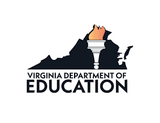
English Instructional Plan – Crowd Sourcing False Premise Analysis and Rewriting for Clarity
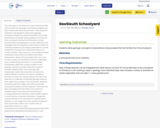
The main goal of this lesson is to get students familiar with the idea that geology is
something tangible and that it affects the world around them. They should be inspired to
ask questions about how geologic processes shaped the world around them and make
observations to answer those questions. All of this on their schoolyard.
During the introductory activity, students learn that geology is a lot like detective work.
Geologists infer the sequence and timing of events by collecting evidence and making
observations, just like a detective.
Students first make observations of a murder mystery.
Then, they try to use simple principles to develop a story that is consistent with these
observations. Many of the principles they use in the murder mystery are exactly the
same as a geologist uses in determining the history of a landscape. Photographs relate the murder mystery to real geology.
Teachers can then take their students outside to explore their new found geologic
interpretation skills. Because every schoolyard is slightly different, teachers will need to
adapt this excursion to their own unique setting. The rest of the web site is a collection
of example geologic features that might have analogs in the schoolyard.
Teachers should browse the images and walk around their schoolyard looking for similar features. There are also links to background information and classroom activities about those features that serve as a jumping off point for teaching a wide variety of topics in earth science.
A teacher could plan a single fifty minute field trip to the schoolyard to explore all the
features, or use images from this section throughout their entire earth science unit.
Content PDF url: https://prd-wret.s3-us-west-2.amazonaws.com/assets/palladium/production/s3fs-public/atoms/files/lessonthreeGeoSleuth_3.pdf
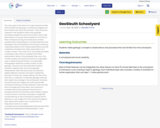
The main goal of this lesson is to get students familiar with the idea that geology is
something tangible and that it affects the world around them. They should be inspired to
ask questions about how geologic processes shaped the world around them and make
observations to answer those questions. All of this on their schoolyard.
During the introductory activity, students learn that geology is a lot like detective work.
Geologists infer the sequence and timing of events by collecting evidence and making
observations, just like a detective.
Students first make observations of a murder mystery.
Then, they try to use simple principles to develop a story that is consistent with these
observations. Many of the principles they use in the murder mystery are exactly the
same as a geologist uses in determining the history of a landscape. Photographs relate the murder mystery to real geology.
Teachers can then take their students outside to explore their new found geologic
interpretation skills. Because every schoolyard is slightly different, teachers will need to
adapt this excursion to their own unique setting. The rest of the web site is a collection
of example geologic features that might have analogs in the schoolyard.
Teachers should browse the images and walk around their schoolyard looking for similar features. There are also links to background information and classroom activities about those features that serve as a jumping off point for teaching a wide variety of topics in earth science.
A teacher could plan a single fifty minute field trip to the schoolyard to explore all the
features, or use images from this section throughout their entire earth science unit.
Content PDF url: https://prd-wret.s3-us-west-2.amazonaws.com/assets/palladium/production/s3fs-public/atoms/files/lessonthreeGeoSleuth_3.pdf

The main goal of this lesson is to get students familiar with the idea that geology is
something tangible and that it affects the world around them. They should be inspired to
ask questions about how geologic processes shaped the world around them and make
observations to answer those questions. All of this on their schoolyard.
During the introductory activity, students learn that geology is a lot like detective work.
Geologists infer the sequence and timing of events by collecting evidence and making
observations, just like a detective.
Students first make observations of a murder mystery.
Then, they try to use simple principles to develop a story that is consistent with these
observations. Many of the principles they use in the murder mystery are exactly the
same as a geologist uses in determining the history of a landscape. Photographs relate the murder mystery to real geology.
Teachers can then take their students outside to explore their new found geologic
interpretation skills. Because every schoolyard is slightly different, teachers will need to
adapt this excursion to their own unique setting. The rest of the web site is a collection
of example geologic features that might have analogs in the schoolyard.
Teachers should browse the images and walk around their schoolyard looking for similar features. There are also links to background information and classroom activities about those features that serve as a jumping off point for teaching a wide variety of topics in earth science.
A teacher could plan a single fifty minute field trip to the schoolyard to explore all the
features, or use images from this section throughout their entire earth science unit.
Content PDF url: https://prd-wret.s3-us-west-2.amazonaws.com/assets/palladium/production/s3fs-public/atoms/files/lessonthreeGeoSleuth_3.pdf
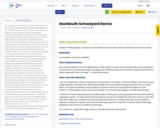
The main goal of this lesson is to get students familiar with the idea that geology is
something tangible and that it affects the world around them. They should be inspired to
ask questions about how geologic processes shaped the world around them and make
observations to answer those questions. All of this on their schoolyard.
During the introductory activity, students learn that geology is a lot like detective work.
Geologists infer the sequence and timing of events by collecting evidence and making
observations, just like a detective.
Students first make observations of a murder mystery.
Then, they try to use simple principles to develop a story that is consistent with these
observations. Many of the principles they use in the murder mystery are exactly the
same as a geologist uses in determining the history of a landscape. Photographs relate the murder mystery to real geology.
Teachers can then take their students outside to explore their new found geologic
interpretation skills. Because every schoolyard is slightly different, teachers will need to
adapt this excursion to their own unique setting. The rest of the web site is a collection
of example geologic features that might have analogs in the schoolyard.
Teachers should browse the images and walk around their schoolyard looking for similar features. There are also links to background information and classroom activities about those features that serve as a jumping off point for teaching a wide variety of topics in earth science.
A teacher could plan a single fifty minute field trip to the schoolyard to explore all the
features, or use images from this section throughout their entire earth science unit.
Content PDF url: https://prd-wret.s3-us-west-2.amazonaws.com/assets/palladium/production/s3fs-public/atoms/files/lessonthreeGeoSleuth_3.pdf
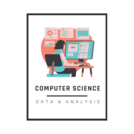
Vocabulary posters for the Data & Analysis strand for Grade 7. Words included are from the 2017 Computer Science Curriculum Framework.
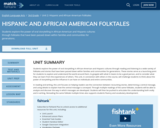
This unit connects with the third grade Social Studies Unit 1, Ancient Rome. In the Social Studies unit, students study and learn about the values and beliefs of the ancient Roman Empire. In this literature unit, students begin to see the role that myths, gods, and storytelling had in ancient Rome by reading a collection on Roman myths. While reading the myths, students will be challenged to think about how the myths illustrate and show the beliefs and customs of the Roman Empire. Students will also be challenged to think what the myths teach about retaliation and generosity.
In reading and writing, this unit focuses on helping readers solidify their understanding of the connection between recounting stories, determining a central message, and using details to explain how the central message is conveyed. Through multiple readings of the same myths, students will be able to analyze and discover the way in which messages are developed. Students will then be pushed to articulate this understanding both orally and in writing. Rereading the same myth multiple times also supports students fluency and vocabulary development.

Adapted from Holzer, Madeline Fuchs (2016). “Every Day We Get More Illegal” by Juan Felipe Herrera. Retrieved from https://edsitement.neh.gov/lesson-plans/every-day-we-get-more-illegal-juan-felipe-herrera.

This collection uses primary sources to explore the impact of television on news media. Digital Public Library of America Primary Source Sets are designed to help students develop their critical thinking skills and draw diverse material from libraries, archives, and museums across the United States. Each set includes an overview, ten to fifteen primary sources, links to related resources, and a teaching guide. These sets were created and reviewed by the teachers on the DPLA's Education Advisory Committee.The remix includes a graphic organizer recording sheet to use with the videos.

This resource provides a simple, focused grading tool to assess literature analysis. It can be applied to demonstrations of skill through writing or speaking.

This resource provides a simple, focused grading tool to assess poetry analysis. It can be applied to demonstrations of skill through writing or speaking.

This is a follow-up lesson to One Word: My Mantra which will allow students to write their "one word" in a different language and create classroom decor that will remind them how the classroom community is linked together to support one another in staying focused on their goals.
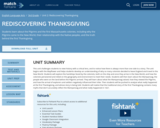
This unit challenges students to view history with a critical lens, and to notice how there is always more than one side to a story. The unit begins with the Mayflower and helps students develop an understanding of why so many colonists decided to leave England and travel to the New World. Students will explore the hardships faced by the colonists, both on the ship and once they arrive in the New World, and how the colonists persevered and relied on the geography and environment to meet their needs. Students will then learn about the Wampanoag, the people who were on the land before the Pilgrims arrived. They will learn about what the Wampanoag valued, how they viewed the Pilgrims, and how the arrival of explorers and settlers negatively influenced their tribe. Then students will be pushed to analyze what really happened at the first Thanksgiving, and whose story is being told. Students will realize that the traditional story of the first Thanksgiving contains many myths that don't accurately reflect the Wampanoag and what really happened in 1621.
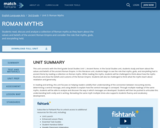
This unit connects with the third grade Social Studies Unit 1, Ancient Rome. In the Social Studies unit, students study and learn about the values and beliefs of the ancient Roman Empire. In this literature unit, students begin to see the role that myths, gods, and storytelling had in ancient Rome by reading a collection on Roman myths. While reading the myths, students will be challenged to think about how the myths illustrate and show the beliefs and customs of the Roman Empire. Students will also be challenged to think what the myths teach about retaliation and generosity.
In reading and writing, this unit focuses on helping readers solidify their understanding of the connection between recounting stories, determining a central message, and using details to explain how the central message is conveyed. Through multiple readings of the same myths, students will be able to analyze and discover the way in which messages are developed. Students will then be pushed to articulate this understanding both orally and in writing. Rereading the same myth multiple times also supports students fluency and vocabulary development.
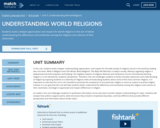
In this unit, students build a deeper understanding, appreciation, and respect for the wide variety of religions found in the world by reading two core texts: What Is Religion? and One World, Many Religions: The Ways We Worship. In today's society, illiteracy regarding religion is widespread and fuels prejudice and bullying. The negative impacts of religious illiteracy and intolerance can be minimized by teaching religion in a non-devotional, academic perspective. Therefore, this unit challenges students to build a broader awareness and understanding of religion by exposing students to a diversity of religious views and educating students about some of the most common religions. It is important to note that this unit is not intended to promote the acceptance of one particular religion or serve as a place to practice religion. Instead, it is our goal that this unit will help students better understand the differences and similarities among the religions and cultures of their classmates, and begin to appreciate and respect differences in religion.
As readers, this unit challenges students to synthesize information across two texts to build a deeper understanding of a topic. Students will analyze how authors support points, what structures they include to emphasize key ideas, and how different texts provide different perspectives and information about similar topics.